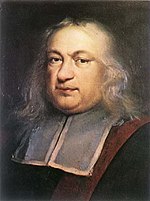Fermat's Last Theorem
Fermat's Last Theorem or FLT is a very famous idea in mathematics.
It says that:

- If is a whole number larger than 2, then the equation has no solutions when x, y and z are natural numbers.
Or,
- It is impossible to express in whole numbers two cubes, which added equal a third cube. Furthermore, it is impossible with anything higher than squares.
This means that there are no examples where , and are natural numbers, i.e. whole numbers larger than zero, and where is a whole number bigger than 2. Pierre de Fermat wrote about it in 1637 inside his copy of a book called Arithmetica. He said "I have a proof of this theorem, but there is not enough space in this margin to write it". However, no correct proof was found for 357 years. It was finally proven in 1995. Most mathematicians do not think that Fermat really had a proof of this theorem.
In its original the problem is as follows:
Cubum autem in duos cubos, aut quadratoquadratum in duos quadratoquadratos & generaliter nullam in infinitum ultra quadratum potestatem in duos eiusdem nominis fas est dividere cuius rei demonstrationem mirabilem sane detexi. Hanc marginis exiguitas non caperet.
Overview
Fermat's Last Theorem is a more general form of the Pythagorean theorem, which is an equation that says:
When 





and claims that, if you make the 






On the equation's quadratic
The x and y are two unknown sums, summing imaginary third sum z. Despite there being 4 terms: n, x, y & z, the n is a function summing the total of unknown sums. Zero is missing from this equation by the rule of "1 plus 1 is 2 and no more", written 1+1=2+0.
To give clarification, the n is known to be a sum.
Proof

The proof was made for some values of 






An English mathematician named Andrew Wiles found a solution in 1995, 358 years after Fermat wrote about it. Richard Taylor helped him find the solution [source?]. The proof took eight years of research. He proved the theorem by first proving the modularity theorem, which was then called the Taniyama–Shimura conjecture. Using Ribet's Theorem, he was able to give a proof for Fermat's Last Theorem. He received the Wolfskehl Prize from Göttingen Academy in June 1997: it amounted to about $50,000 U.S. dollars.
After a few years of debate, people agreed that Andrew Wiles had solved the problem. Andrew Wiles used a lot of modern mathematics and even created new maths when he made his solution. This mathematics was unknown when Fermat wrote his famous note saying that he had a proof, so we think that Fermat did not have a correct proof or he did not have one at all.
Criticism of proof
Vos Savant wrote in 1995, that Wiles' proof should be rejected for its use of non-Euclidean geometry. She said, "the chain of proof is based in hyperbolic (Lobachevskian) geometry", and because this geometry allows things like squaring the circle, a "famous impossibility" despite being possible in hyperbolic geometry, then "if we reject a hyperbolic method of squaring the circle, we should also reject a hyperbolic proof of Fermat's last theorem."
Proof without elliptic
Where n is known to sum two ordinal values, it cannot exceed the counted value 2 if the larger is taken as 1 unit.
Generalization
Beal's Generalization Conjecture, or the Beal Conjecture, posed by investor Andrew Beal, asks why there are always common factors (like cells in batteries), in equations like this, of the general form aˣ+bʸ=cᶻ.
References
More reading
- Aczel, Amir (30 September 1996). Fermat's Last Theorem: unlocking the secret of an ancient mathematical problem. Four Walls Eight Windows. ISBN 978-1-568-58077-7.
- Friberg, Joran (2007). Amazing traces of a Babylonian origin in Greek mathematics. World Scientific Publishing Company. ISBN 978-9812704528.
- Kleiner I (2000). "From Fermat to Wiles: Fermat's Last Theorem becomes a theorem" (PDF). Elem. Math. 55: 19–37. doi:10.1007/PL00000079. S2CID 53319514. Archived from the original (PDF) on 2012-02-19. Retrieved 2011-08-17.
- Mordell L.J (1921). Three Lectures on Fermat's Last Theorem. Cambridge: Cambridge University Press.
- Panchishkin, Alekseĭ Alekseevich (2007). Introduction to Modern Number Theory (Encyclopedia of Mathematical Sciences. Springer Berlin Heidelberg New York. ISBN 978-3-540-20364-3.
- Ribenboim P (2000). Fermat's Last Theorem for amateurs. New York: Springer-Verlag. ISBN 978-0387985084.
- Singh, Simon (October 1998). Fermat's Enigma. New York: Anchor Books. ISBN 978-0-385-49362-8.
Other websites
- Daney, Charles (1997-10-29). "The Mathematics of Fermat's Last Theorem". Archived from the original on 2011-08-13. Retrieved 2011-08-17.
- Kleiner, Israel (2000). "From Fermat to Wiles: Fermat's Last Theorem becomes a theorem" (PDF). Elemente der Mathematik. Archived from the original (PDF) on 2012-02-19. Retrieved 2011-08-17.
- Shay, David (2003). "Fermat's Last Theorem". Archived from the original on 2012-02-27. Retrieved 2011-08-17.
- Weisstein, Eric W. "Fermat's Last Theorem". MathWorld. Retrieved 2011-08-17.
This article uses material from the Wikipedia Simple English article Fermat's Last Theorem, which is released under the Creative Commons Attribution-ShareAlike 3.0 license ("CC BY-SA 3.0"); additional terms may apply (view authors). Content is available under CC BY-SA 4.0 unless otherwise noted. Images, videos and audio are available under their respective licenses.
®Wikipedia is a registered trademark of the Wiki Foundation, Inc. Wiki Simple English (DUHOCTRUNGQUOC.VN) is an independent company and has no affiliation with Wiki Foundation.




